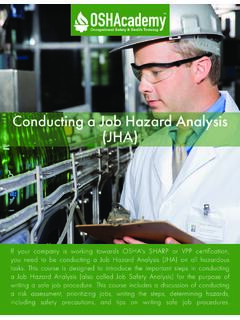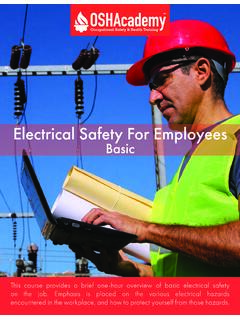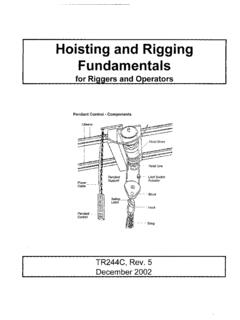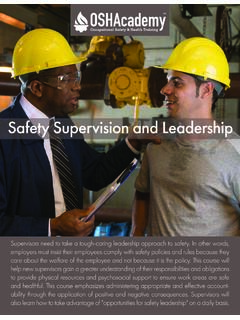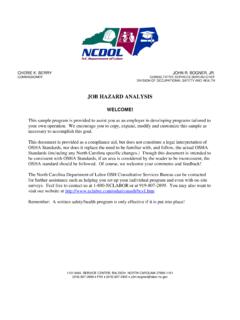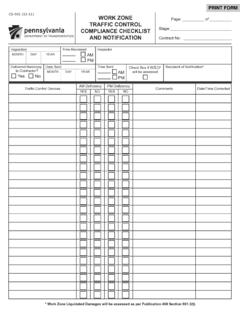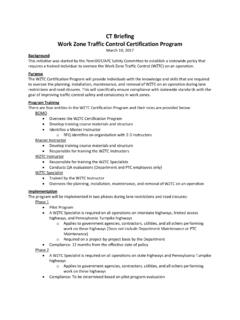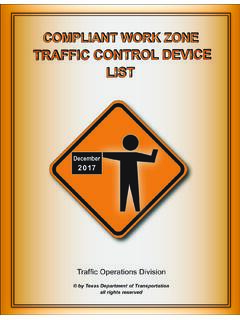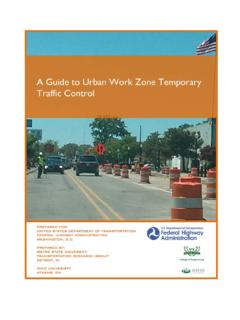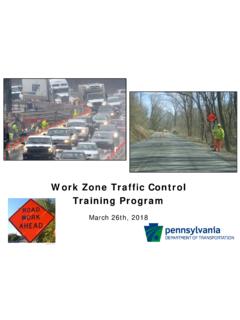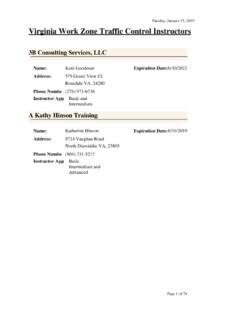Transcription of 612 Work Zone Traffic Safety - OSHA Training
1 Road construction workers on both highways and city streets are at risk of fatal or serious injuries. The majority of road work takes place in congested areas with exposure to high Traffic volumes and speeds. Workers may also deal with low lighting, low visibility, and inclement weather conditions. Moving construction vehicles and passing motor vehicle Traffic can both cause problems for road construction workers. This course discusses important ways to protect yourself, your co-workers, pedestrians, and motorists in a road construction zone.
2 work Zone Traffic SafetyCourse 612 This page intentionally blank Course 612 OSHA cademy Course 612 Study Guide work Zone Traffic Safety Copyright 2020 Geigle Safety Group, Inc. No portion of this text may be reprinted for other than personal use. Any commercial use of this document is strictly forbidden. Contact OSHA cademy to arrange for use as a Training document. This study guide is designed to be reviewed off-line as a tool for preparation to successfully complete OSHA cademy Course 612. Read each module, answer the quiz questions, and submit the quiz questions online through the course webpage.
3 You can print the post-quiz response screen which will contain the correct answers to the questions. The final exam will consist of questions developed from the course content and module quizzes. We hope you enjoy the course and if you have any questions, feel free to email or call: OSHA cademy 15220 NW Greenbrier Parkway, Suite 230 Beaverton, Oregon 97006 +1 (888) 668-9079 Disclaimer This document does not constitute legal advice. Consult with your own company counsel for advice on compliance with all applicable state and federal regulations. Neither Geigle Safety Group, Inc.
4 , nor any of its employees, subcontractors, consultants, committees, or other assignees make any warranty or representation, either express or implied, with respect to the accuracy, completeness, or usefulness of the information contained herein, or assume any liability or responsibility for any use, or the results of such use, of any information or process disclosed in this publication. GEIGLE Safety GROUP, INC., DISCLAIMS ALL OTHER WARRANTIES EXPRESS OR IMPLIED INCLUDING, WITHOUT LIMITATION, ANY WARRANTIES OF MERCHANTABILITY OR FITNESS FOR A PARTICULAR PURPOSE. Taking actions suggested in this document does not guarantee that an employer, employee, operator or contractor will be in compliance with applicable regulations.
5 Ultimately every company is responsible for determining the applicability of the information in this document to its own operations. Each employer s Safety management system will be different. Mapping Safety and environmental management policies, procedures, or operations using this document does not guarantee compliance regulatory requirements. Revised: May 11, 2020 Course 612 This page intentionally blankCourse 612 Copyright 2020 Geigle Safety Group, Inc. Page 1 of 23 Contents Course Introduction ..3 Course Components ..3 Module 1: work Zone and Roadway Risks.
6 4 Risks in and Around work zones ..4 Traffic Control Plans ..4 Temporary Traffic Control Plans (TTCPs)..5 Internal Traffic Control Plans (ITCPs) ..6 Risk Factors in the work Zone ..7 Equipment Operator Risk Factors ..7 Traffic Control in work zones ..7 work Zone Best Practices ..8 Risks in the Roadway ..9 Roadway Best Practices ..10 Module 2: Blind Spot Safety ..13 Blind Spot Hazards ..13 Blind Spot Hazards ..13 Operating Dump Trucks in Real-Life Accident ..15 Backing Safety Solutions ..15 Spotter ..15 Cameras ..16 Proximity Detection Systems ..16 Module 3: Signs, Signals, and Barricades.
7 18 Signs for Construction ..18 Danger signs ..18 Caution signs ..18 Exit Signs ..19 Safety Instruction Signs ..19 Directional Signs ..19 Course 612 Copyright 2020 Geigle Safety Group, Inc. Page 2 of 23 Traffic Control Signs and Devices ..19 Accident Prevention Tags ..19 Signals ..20 Flaggers ..20 Spotters ..20 Crane and Hoist Signal Persons ..20 Channelizing Devices ..21 Barricades ..22 Endnotes ..23 Course 612 Copyright 2020 Geigle Safety Group, Inc. Page 3 of 23 Course Introduction Road construction workers on both highways and city streets are at risk of fatal or serious injuries.
8 The majority of road work takes place in congested areas with exposure to high Traffic volumes and speeds. Workers may also deal with low lighting, low visibility, and inclement weather conditions. Moving construction vehicles and passing motor vehicle Traffic can both cause problems for road construction workers. This course discusses important ways to protect yourself, your co-workers, pedestrians, and motorists in a road construction zone. Course Components Once you complete this course, you will have knowledge in the following items: 1. roadway worker risks 2. equipment operator risk factors 3.
9 Temporary Traffic control plans 4. working at night 5. protecting workers in work zones 6. blind spot hazards 7. backing Safety solutions 8. spotting hand signals Course 612 Copyright 2020 Geigle Safety Group, Inc. Page 4 of 23 Module 1: work Zone and Roadway Risks On average, over 700 fatalities occur in work zones each year. Commercial motor vehicle (CMV) and passenger vehicle drivers both need to be particularly careful while traveling through work zones . Trucks and buses have limited maneuverability and large blind spots, both of which make operating in these areas more challenging for them.
10 In fact, large trucks are disproportionately involved in work zone crashes. Risks in and Around work zones Workers in highway work zones are most often exposed to risk to injury from the movement of construction vehicles and equipment within and around work zones . 1. Highway workers routinely work close to construction vehicles and motor vehicle Traffic . 2. Highway workers work in conditions of low lighting, low visibility, and inclement weather, and may work in congested areas with exposure to high Traffic volume and speeds. 3. Vehicle or equipment operators risk injury due to overturn, collision, or being caught in running equipment.




